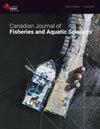TROPHIC ECOLOGY OF JUVENILE LEAN AND SISCOWET LAKE CHARR (Salvelinus namaycush) IN LAKE SUPERIOR: ASSESSING FOR POTENTIAL COMPETITION
IF 2.2
2区 农林科学
Q2 FISHERIES
Canadian Journal of Fisheries and Aquatic Sciences
Pub Date : 2023-10-16
DOI:10.1139/cjfas-2023-0102
引用次数: 0
Abstract
We investigated the spatial overlap, diet, isotopic niche, and growth of juvenile lean and siscowet lake charr (Salvelinus namaycush) in Lake Superior to address concerns of potential competition with implications to the study of resource polymorphism. Catch data revealed the greatest levels of sympatry in waters from 40-60 m. Juvenile lean and siscowet diet changed ontogenetically with Mysis dominant prey item for the smallest lake charr but differentiating with onset of piscivory. As ecotypes increased in size, lean diets became dominated by pelagic prey whereas siscowets had equal proportions of benthic and pelagic prey. Isotopic niche overlap declined between ecotypes coincident with siscowet lake charr shifting to deeper habitats around 400 mm. Lean and siscowet exhibited different growth trajectories. However, length at age-4 declined in parallel for both ecotypes with no trend in condition suggesting that lake charr growth is sensitive to prey biomass and unlikely related to competition. Our findings indicate minimal evidence of competition and support the concept that multiple sympatric ecotypes of lake charr in Lake Superior are maintained by resource polymorphism.苏必利尔湖幼鱼和咸鱼的营养生态学:潜在竞争的评估
本文通过对苏必利尔湖瘦湖鲑(Salvelinus namaycush)幼鱼的空间重叠、食性、同位素生态位和生长进行研究,探讨潜在竞争对资源多态性研究的影响。渔获数据显示,40-60米水域的共情水平最高。幼鱼的瘦肉和瘦肉在个体遗传学上发生了变化,在最小的湖鲑中以米西斯为主要猎物,但随着鱼类的开始而分化。随着生态型体型的增加,瘦肉饮食以远洋猎物为主,而绢尾鱼的底栖和远洋猎物比例相等。随着湖炭向400 mm左右深生境迁移,各生态型间同位素生态位重叠减小。Lean和siscowet表现出不同的生长轨迹。然而,4岁时两种生态型的体长均呈平行下降趋势,但没有变化趋势,这表明湖炭的生长对猎物生物量很敏感,与竞争关系不大。我们的研究结果表明,竞争的证据很少,并支持了苏必利尔湖多种同域生态类型是由资源多态性维持的概念。
本文章由计算机程序翻译,如有差异,请以英文原文为准。
求助全文
约1分钟内获得全文
求助全文
来源期刊

Canadian Journal of Fisheries and Aquatic Sciences
农林科学-海洋与淡水生物学
CiteScore
4.60
自引率
12.50%
发文量
148
审稿时长
6-16 weeks
期刊介绍:
The Canadian Journal of Fisheries and Aquatic Sciences is the primary publishing vehicle for the multidisciplinary field of aquatic sciences. It publishes perspectives (syntheses, critiques, and re-evaluations), discussions (comments and replies), articles, and rapid communications, relating to current research on -omics, cells, organisms, populations, ecosystems, or processes that affect aquatic systems. The journal seeks to amplify, modify, question, or redirect accumulated knowledge in the field of fisheries and aquatic science.
 求助内容:
求助内容: 应助结果提醒方式:
应助结果提醒方式:


